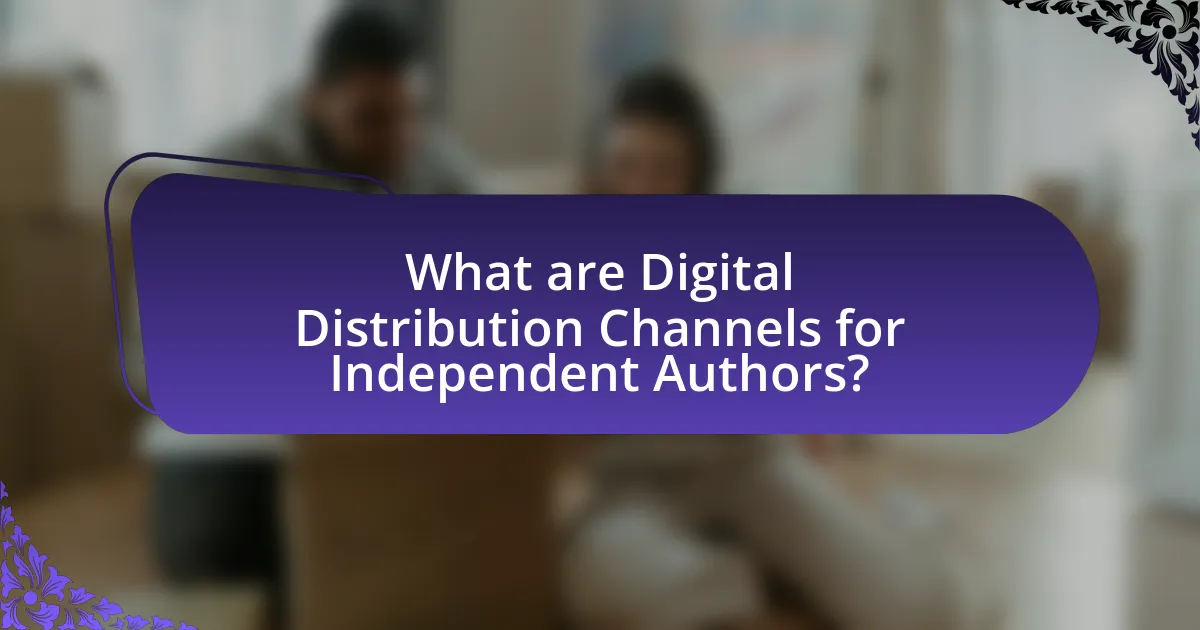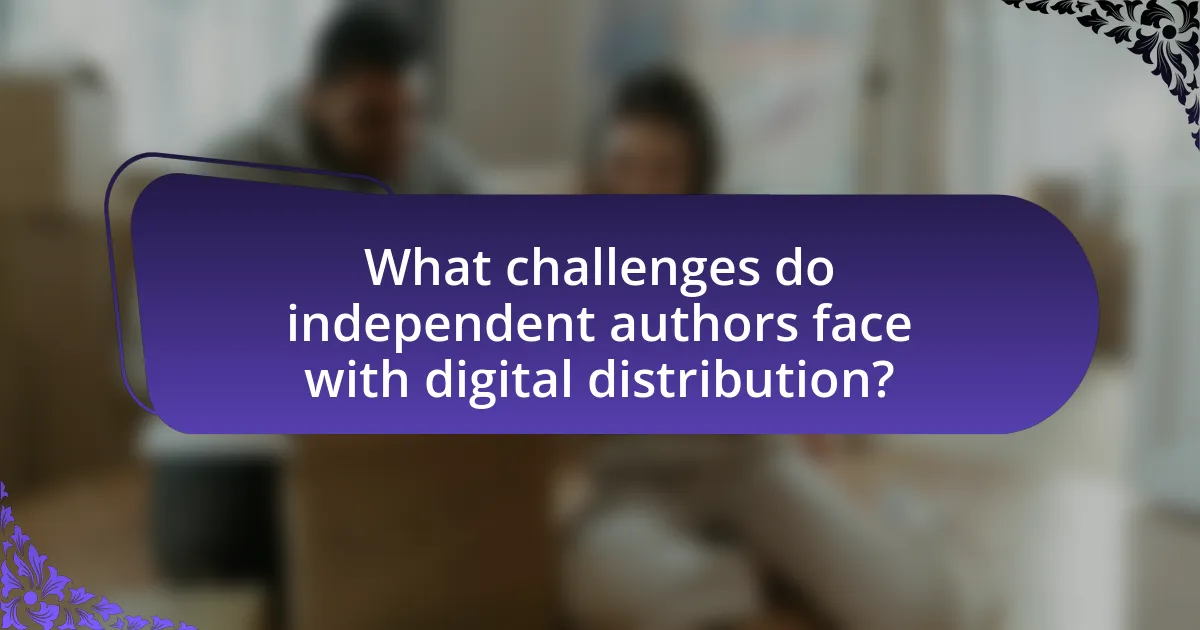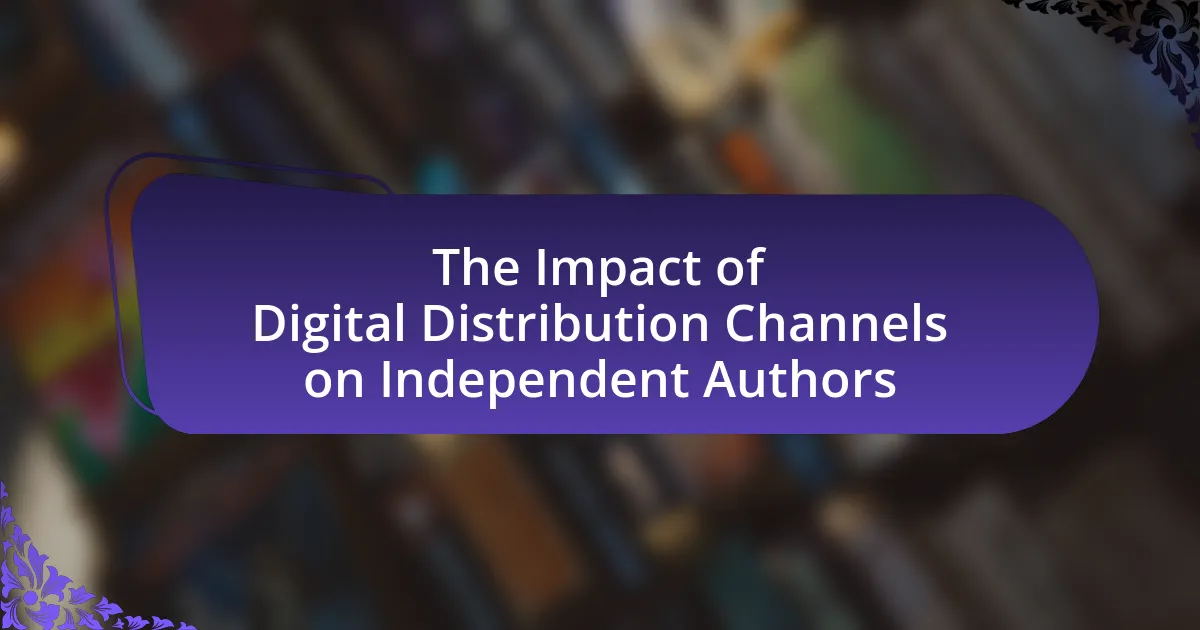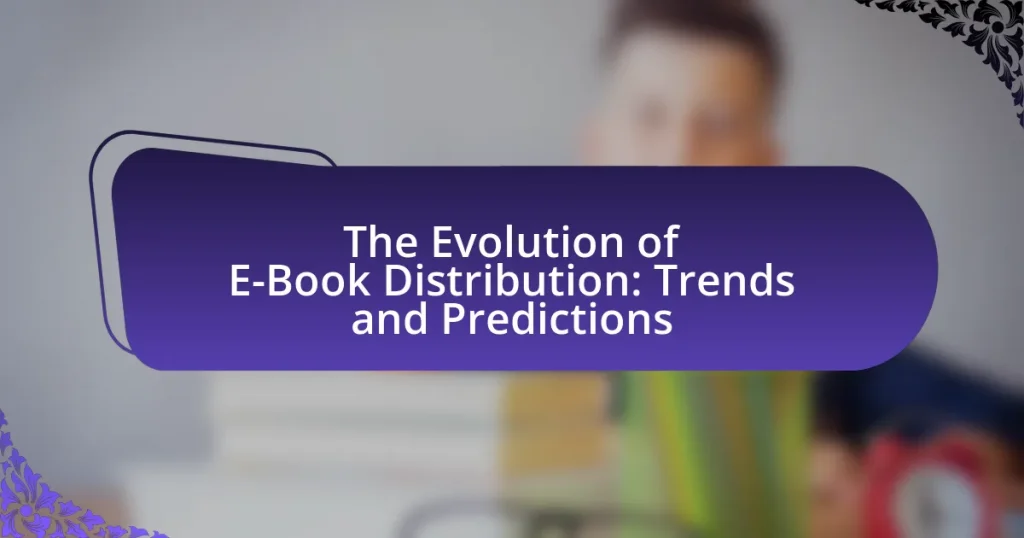Digital distribution channels are essential platforms for independent authors, enabling them to publish and distribute their works globally without traditional publishing constraints. Key channels include Amazon Kindle Direct Publishing, Smashwords, Draft2Digital, and IngramSpark, which provide authors with greater control over their publishing process and higher royalty rates. The article explores how these channels function within the publishing industry, the advantages they offer over traditional methods, and the challenges independent authors face, such as market saturation and technical barriers. Additionally, it discusses strategies for overcoming these challenges and the future of digital distribution, emphasizing the role of emerging technologies and data analytics in shaping the landscape for independent authors.

What are Digital Distribution Channels for Independent Authors?
Digital distribution channels for independent authors include platforms such as Amazon Kindle Direct Publishing, Smashwords, Draft2Digital, and IngramSpark. These channels allow authors to publish and distribute their works in digital formats, reaching a global audience without the need for traditional publishing houses. For instance, Amazon Kindle Direct Publishing enables authors to upload their eBooks directly to the Kindle Store, providing access to millions of readers. Smashwords and Draft2Digital offer wide distribution to various retailers and libraries, while IngramSpark provides access to a vast network of bookstores and online retailers. These channels empower independent authors by offering greater control over their publishing process and potential revenue streams.
How do digital distribution channels function in the publishing industry?
Digital distribution channels in the publishing industry function by enabling authors and publishers to deliver their content directly to consumers through online platforms. These channels include e-book retailers, online marketplaces, and subscription services, which facilitate the sale and distribution of digital books without the need for traditional print distribution. For instance, platforms like Amazon Kindle Direct Publishing allow independent authors to upload their works, set pricing, and reach a global audience, significantly reducing barriers to entry in the market. This model has been validated by the rapid growth of e-book sales, which accounted for approximately 20% of all book sales in the U.S. in 2022, demonstrating the effectiveness of digital distribution in reaching readers efficiently.
What types of digital distribution channels are available for independent authors?
Independent authors have access to several types of digital distribution channels, including eBook platforms, print-on-demand services, and audiobook distributors. eBook platforms such as Amazon Kindle Direct Publishing, Apple Books, and Kobo allow authors to publish and sell their digital books directly to consumers. Print-on-demand services like IngramSpark and CreateSpace enable authors to produce physical copies of their books without upfront inventory costs. Audiobook distributors, such as Audible and Findaway Voices, provide avenues for authors to reach audiences through audio formats. These channels collectively empower independent authors to reach diverse markets and maximize their sales potential.
How do these channels differ from traditional publishing methods?
Digital distribution channels differ from traditional publishing methods primarily in their accessibility and speed of publication. Independent authors can publish their work instantly through platforms like Amazon Kindle Direct Publishing or Smashwords, bypassing the lengthy submission and approval processes typical of traditional publishing houses. This shift allows for greater creative control and the ability to reach global audiences without the constraints of geographical limitations or gatekeeping by publishers. Additionally, digital channels often provide authors with higher royalty rates, sometimes up to 70%, compared to the 10-15% typically offered by traditional publishers.
Why are digital distribution channels important for independent authors?
Digital distribution channels are crucial for independent authors because they provide direct access to a global audience without the need for traditional publishing gatekeepers. These channels, such as Amazon Kindle Direct Publishing and Smashwords, enable authors to publish and distribute their work quickly and efficiently, often at lower costs than traditional publishing methods. According to a 2021 report by the Independent Book Publishers Association, self-published authors can earn up to 70% of royalties on their sales through these platforms, significantly higher than the typical 10-15% offered by traditional publishers. This financial incentive, combined with the ability to reach readers worldwide, underscores the importance of digital distribution channels for independent authors.
What advantages do digital channels provide over traditional publishing?
Digital channels offer several advantages over traditional publishing, including wider reach, lower costs, and faster distribution. Digital platforms enable independent authors to access a global audience instantly, as evidenced by the fact that eBooks accounted for over 20% of book sales in the U.S. in 2021, according to the Association of American Publishers. Additionally, the cost of publishing digitally is significantly lower, with authors avoiding expenses related to printing and physical distribution. Furthermore, digital channels allow for real-time updates and revisions, enhancing the author’s ability to respond to market trends quickly.
How do digital channels enhance an author’s reach and visibility?
Digital channels enhance an author’s reach and visibility by providing platforms for direct engagement with a global audience. These channels, such as social media, blogs, and e-commerce sites, allow authors to share their work widely, bypassing traditional publishing barriers. For instance, a study by the Pew Research Center found that 69% of adults in the U.S. use social media, which can significantly amplify an author’s promotional efforts. Additionally, platforms like Amazon Kindle Direct Publishing enable authors to publish and distribute their work instantly, reaching millions of potential readers. This accessibility and direct connection to audiences increase the likelihood of discovering new authors and their works, thereby enhancing visibility and expanding readership.

What challenges do independent authors face with digital distribution?
Independent authors face several challenges with digital distribution, including market saturation, limited visibility, and technical barriers. Market saturation occurs as thousands of new titles are published daily, making it difficult for individual authors to stand out. Limited visibility is exacerbated by algorithms used by platforms like Amazon, which often prioritize established authors or those with significant marketing budgets, leaving independent authors struggling to gain traction. Technical barriers, such as formatting requirements and understanding distribution platforms, can also hinder authors who may lack the necessary skills or resources to navigate the digital landscape effectively. These challenges collectively impact the ability of independent authors to reach their target audience and achieve sales success.
What are the common obstacles in utilizing digital distribution channels?
Common obstacles in utilizing digital distribution channels include technical challenges, market saturation, and lack of visibility. Technical challenges arise from the need for authors to navigate complex platforms and ensure compatibility with various devices. Market saturation occurs as numerous independent authors compete for attention, making it difficult for individual works to stand out. Lack of visibility is exacerbated by algorithms that prioritize established authors or popular titles, limiting exposure for new entrants. According to a 2021 survey by the Independent Book Publishers Association, 70% of independent authors reported difficulties in gaining visibility on digital platforms, highlighting the significant barriers they face in effectively utilizing these channels.
How do issues like competition and market saturation affect independent authors?
Competition and market saturation significantly hinder independent authors by limiting their visibility and sales potential. As more authors enter the market, particularly through digital distribution channels, the sheer volume of available titles makes it challenging for individual works to stand out. For instance, in 2020, over 1.7 million books were self-published in the United States alone, creating a saturated environment where readers face overwhelming choices. This saturation often leads to lower sales for independent authors, as they struggle to capture the attention of potential readers amidst a crowded marketplace. Additionally, increased competition can drive down prices, further impacting the profitability of independent authors.
What technical challenges might authors encounter when using these channels?
Authors may encounter several technical challenges when using digital distribution channels, including platform compatibility issues, formatting requirements, and data management complexities. For instance, different platforms may require specific file formats, which can lead to additional work for authors to ensure their content is properly formatted for each channel. Additionally, authors often face difficulties in managing metadata and tracking sales data across multiple platforms, which can complicate their marketing and sales strategies. According to a survey by the Independent Book Publishers Association, 45% of independent authors reported challenges with understanding the technical specifications of various distribution platforms, highlighting the prevalence of these issues in the industry.
How can independent authors overcome these challenges?
Independent authors can overcome challenges by leveraging digital marketing strategies and utilizing multiple distribution platforms. By employing targeted social media advertising, authors can reach specific audiences, increasing visibility and sales. Additionally, using platforms like Amazon Kindle Direct Publishing and Smashwords allows authors to distribute their work widely, maximizing potential readership. Research indicates that authors who actively engage with their audience through newsletters and social media see a significant increase in book sales, with a 2019 survey by the Alliance of Independent Authors revealing that 70% of successful indie authors prioritize marketing efforts.
What strategies can authors implement to improve their digital distribution success?
Authors can improve their digital distribution success by leveraging multiple online platforms, optimizing their metadata, and engaging in targeted marketing strategies. Utilizing platforms like Amazon Kindle Direct Publishing, Smashwords, and Draft2Digital allows authors to reach diverse audiences. Optimizing metadata, including keywords and categories, enhances discoverability in search results, increasing the likelihood of sales. Additionally, targeted marketing strategies, such as social media advertising and email newsletters, can effectively reach potential readers. According to a 2021 survey by the Independent Book Publishers Association, authors who actively engage in marketing see a 30% increase in sales compared to those who do not.
How can authors leverage social media and marketing to enhance their distribution efforts?
Authors can leverage social media and marketing by creating targeted campaigns that engage their audience and promote their work effectively. Utilizing platforms like Facebook, Instagram, and Twitter allows authors to reach potential readers directly, build a community, and share updates about their books. For instance, a study by the Pew Research Center indicates that 72% of adults use at least one social media site, providing a vast audience for authors to tap into. Additionally, authors can use paid advertising on these platforms to enhance visibility, with Facebook Ads reporting an average return on investment of $2 for every $1 spent. By consistently engaging with followers through content such as behind-the-scenes looks, book trailers, and interactive posts, authors can foster loyalty and drive sales, ultimately enhancing their distribution efforts.

What is the future of digital distribution for independent authors?
The future of digital distribution for independent authors is increasingly promising, driven by advancements in technology and changing consumer behaviors. Independent authors are expected to benefit from a growing array of platforms that facilitate direct sales and wider reach, such as Amazon Kindle Direct Publishing, Apple Books, and various self-publishing services. According to a 2021 report by the Independent Book Publishers Association, the self-publishing market has seen a significant increase, with over 1.7 million self-published titles released in 2020 alone, indicating a robust demand for independent works. Additionally, the rise of social media and digital marketing tools allows authors to engage directly with their audience, enhancing their visibility and sales potential. This trend suggests that independent authors will continue to thrive in a digital-first landscape, leveraging innovative distribution methods to reach readers globally.
How are emerging technologies shaping digital distribution channels?
Emerging technologies are transforming digital distribution channels by enhancing accessibility, efficiency, and personalization for content delivery. Innovations such as blockchain, artificial intelligence, and cloud computing streamline the distribution process, allowing independent authors to reach global audiences with minimal barriers. For instance, blockchain technology enables secure and transparent transactions, ensuring authors receive fair compensation for their work. Additionally, AI-driven algorithms analyze consumer behavior, allowing for targeted marketing strategies that increase visibility and sales. According to a report by the International Publishers Association, the adoption of these technologies has led to a 30% increase in digital sales for independent authors over the past five years, demonstrating their significant impact on the industry.
What role does data analytics play in the future of digital distribution?
Data analytics will play a crucial role in the future of digital distribution by enabling independent authors to make data-driven decisions that enhance their marketing strategies and optimize their distribution channels. By analyzing consumer behavior, sales trends, and engagement metrics, authors can tailor their content and promotional efforts to meet the specific preferences of their target audience. For instance, a study by the Pew Research Center indicates that 70% of consumers are influenced by personalized recommendations, highlighting the importance of data analytics in understanding reader preferences. This capability allows independent authors to effectively position their work in a competitive market, ultimately leading to increased visibility and sales.
How might changes in consumer behavior impact independent authors?
Changes in consumer behavior can significantly impact independent authors by altering their sales patterns and marketing strategies. For instance, a shift towards digital consumption, where readers prefer e-books and audiobooks, can lead independent authors to focus more on digital platforms for distribution. According to a 2021 report by the Association of American Publishers, e-book sales increased by 16.5% in 2020, indicating a growing preference for digital formats. This trend compels independent authors to adapt their publishing strategies, invest in digital marketing, and engage with readers through social media to maintain visibility and sales. Additionally, changes in consumer preferences for diverse genres or themes can influence the types of content that independent authors choose to create, ultimately affecting their market reach and profitability.
What best practices should independent authors follow for effective digital distribution?
Independent authors should utilize multiple digital distribution platforms to maximize their reach and sales potential. By distributing their work across various channels such as Amazon Kindle Direct Publishing, Apple Books, and Google Play Books, authors can access diverse audiences and increase visibility. Research indicates that authors who leverage multiple platforms can see a significant increase in sales, with some reports showing up to a 30% boost in revenue compared to those who limit themselves to a single platform. Additionally, authors should optimize their metadata, including keywords and categories, to enhance discoverability in search results. This practice is supported by data from the Author Earnings report, which highlights the importance of effective metadata in driving sales. Finally, engaging with readers through social media and email newsletters can foster a loyal fan base, further enhancing distribution success.
How can authors optimize their content for various digital platforms?
Authors can optimize their content for various digital platforms by tailoring their writing style, format, and promotional strategies to fit the specific characteristics and audience preferences of each platform. For instance, on social media platforms like Twitter, authors should use concise language and engaging visuals to capture attention quickly, while on blogs, longer, in-depth articles with SEO optimization can enhance visibility. Research indicates that 70% of consumers prefer to learn about a company through articles rather than ads, highlighting the importance of quality content across platforms. Additionally, utilizing analytics tools to track engagement metrics allows authors to refine their strategies based on audience feedback and behavior, ensuring that their content resonates effectively with each digital channel.
What are the key metrics authors should track to measure success in digital distribution?
Authors should track sales volume, revenue, and reader engagement metrics to measure success in digital distribution. Sales volume indicates the number of units sold, providing a direct measure of market demand. Revenue reflects the financial return from those sales, essential for assessing profitability. Reader engagement metrics, such as downloads, reviews, and ratings, offer insights into audience interaction and satisfaction, which are critical for long-term success. Tracking these metrics allows authors to make informed decisions about marketing strategies and content development, ultimately enhancing their presence in the digital marketplace.



